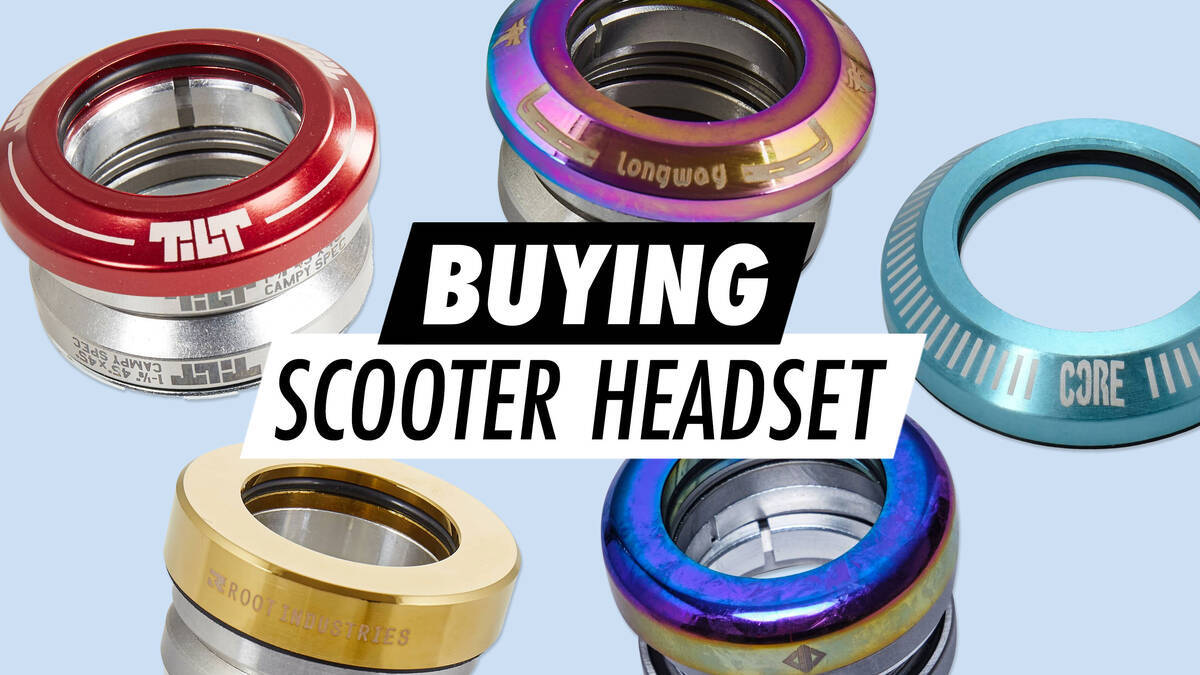Stunt Scooter Headset Purchaser's Guide

Here is our guide on stunt scooter headsets. Selecting a new headset for your stunt scooter is unlikely to go wrong. Just keep in mind that the headset bearings allow your fork and bars to rotate smoothly when you perform bar spins or manoeuvre your deck in the air.
Understanding the basic function of a scooter headset and its installation can be beneficial when seeking the ideal scooter headset. Ready to enhance your scooter? Prepare to learn the essential elements of selecting the appropriate headset for your configuration.
Overview
Defining a Stunt Scooter Headset

The headset facilitates the fork's smooth rotation within the deck's head tube. A stunt scooter headset generally comprises the following components:
1: Crown Race
Typically included in scooter headsets, a crown race is often unnecessary because most forks possess a built-in crown race. It serves as the location where the headset bearing rests on the scooter fork.
2: Headset Bearings
Bearings are the headset's vital elements, provided as a pair – one for the top, one for the bottom. They are usually sealed to ensure durability and smooth functioning. If you find a headset with open bearings, it is advised to choose one with sealed bearings, as they provide extended lifespan.
3: C-Ring
The C-ring is essential for stabilising the fork within the headset by filling the space around the fork tube. Compression applies pressure to the C-ring, making it a crucial part of the assembly. If you use IHC compression, it is important to use a mini C-ring.
4: Top Cap / Dust Cover
The dust cover's main function is to shield the bearings from dirt and debris, ensuring continued smooth rotation.
Explaining Integrated Headset: Integrated vs Non-Integrated Headsets
Many scooter headsets are labeled as integrated; however, because most scooter decks now feature integrated bearing cups, the term "integrated headset" is generally insignificant in the context of scootering. Decks are occasionally referred to as integrated decks, indicating that the headtube is shaped with integrated bearing cups.
Non-integrated headsets require knocking in two headset cages or bearing cups into the deck's headtube before fitting the bearings. Beginner-level trick scooters may still use non-integrated headsets, whereas integrated headsets are typically found in higher performance complete stunt scooters.
Installing a Scooter Headset
Fitting a headset on a stunt scooter is quite straightforward. Below is a video offering a step-by-step installation guide for an integrated headset.
Apply grease to the bearing cups, insert the headset bearings into the top and bottom, then slide the fork through the headset. Following this, install the C-ring and the dust cap.
Ensure you correctly position the bearings – they have a "tapered" design that fits perfectly within the deck's bearing cup.
Utilise grease to facilitate easier headset replacement and prevent wear on the bearing cup.
Pro Scooter Headset Compatibility
There are not many variables to confuse you when finding the most compatible headset for your custom stunt scooter. High-quality aftermarket headsets and scooter decks are all integrated and maintain uniform sizes.
IHC is the only exception. IHC forks feature narrower fork tubes, necessitating a mini C-ring. You likely already have a mini C-ring with your fork, compression kit, or pre-installed in a complete scooter setup. If not, it can be found here:
Maintaining a Scooter Headset
There are several measures to take for maintaining your headset, ensuring excellent performance and durability. Properly installed headsets rely on smoothly spinning ball bearings. Should you notice friction or suspect dirt inside the headset, it's advisable to promptly address such issues before they worsen over time.
To disassemble the headset:
- Detach the bar and compression system.
- Carefully remove the fork, taking care not to damage the headset bearings.
Evaluate the condition of the bearings:
- Replace visibly damaged bearings with a new headset.
- If the bearings appear dirty or greasy, clean them accordingly.
Cleaning the headset bearings:
- Submerge them in a cleaning solution and stir after allowing the solution to act for a few minutes.
- Dry the bearings thoroughly.
Bearings lubrication:
- After drying, apply a small quantity of bearing lubricant.
- Rotate the bearings to evenly distribute the lubricant.
- Wipe the deck's bearing cups with a clean cloth, then apply new grease.
And there you have it – time to reinstall the headset!
For a comprehensive guide on cleaning bearings, reference our guide:
Additional Reading
We suggest checking out our guide to scooter compression if you're unsure about terms like SCS, IHC, or HIC:
The following guides also offer important information about scooter compression:
